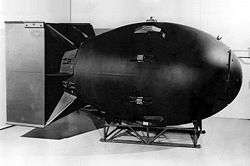Atomic veteran
| Nuclear weapons |
|---|
 |
| Background |
| Nuclear-armed states |
|
Atomic veterans are United States military veterans who were exposed to ionizing radiation while stationing in the Japanese cities of Hiroshima and Nagasaki during the American occupation of Japan before 1946 (including certain veterans who were prisoners of war there) and thousands of servicemen who took part in atmospheric nuclear tests (1945-1962).
Affected veterans
The Defense Threat Reduction Agency's Nuclear Test Personnel Review has maintained a database of participants and radiation dose reconstructions since 1978. Dose reconstructions are used by the United States Department of Veterans Affairs (VA) to evaluate and decide veterans' claims filed under the provisions of Public Law (PL) 98-542 and implementing regulations in Title 38 of the Code of Federal Regulations, part 3.311.[1]
John Smitherman, was a navy pilot involved in the 1946 Bikini Atoll nuclear explosions, which resulted in extensive radioactive contamination of the area. Cancer of the lymphatic system, and two leg amputations, resulted for Smitherman, who became president of the National Association of Atomic Veterans.[2] Smitherman featured in Robert Stone's documentary film Radio Bikini, which was nominated for an Academy Award in 1988.[3]
Investigation
A formal investigation[4] of the radiation exposure these veterans received, as well as radiation experiments conducted on humans, was initiated in 1994, by former President Bill Clinton, who apologized for their treatment in 1995.[5] "In 1996, the U.S. Congress repealed the Nuclear Radiation Secrecy Agreement Act, which rescinded the Atomic Veteran “oath-of-secrecy”,[6] thus allowing Atomic-Veterans the opportunity to recount stories of their participation in Nuclear weapon testing and post test event activities, without legal penalty.[7] By this time,however, many thousands of Atomic Veterans, the majority of whom were afflicted with a host of radiation induced health issues, such as cancer, had taken that “secret”[8] with them, to their graves.[9][10]
The remaining atomic veterans may receive special priority enrollment for health care services from VA for radiation-related conditions. In addition, atomic veterans are eligible to participate in an ionizing radiation registry examination program operated by VA.[11][12]
Unfortunately, the only copies of service and medical records for many of these veterans were lost in a fire at the National Archives in 1973.[13] Veterans, or families of deceased Veterans, whose records were lost in the fire, were denied these services and must go through an extensive reconstruction process in order to establish their presence during the time of atmospheric tests.
Compensation
The United States Department of Justice (DOJ) has a different compensation program established by the Radiation Exposure Compensation Act (RECA) which was passed by the United States Congress on October 5, 1990, and signed into law by President George H. W. Bush on October 15.[14] Atomic veterans who participated in atmospheric nuclear tests may be eligible.[15]
The Radiation Exposure Compensation Act was amended in 2013 and enlarged the geographic exposure area and the amount of compensation payable to Atomic Veterans and people living downwind of the tests. Other compensation may also be available from the United States Department of Labor under section SEC of the Energy Employees Occupational Illness Compensation Program.[16]
Epidemiological studies of Japanese atomic bomb survivors have shown exposure to radiation to be associated with a number of disorders including leukemia, various cancers and cataracts.[17] It has been determined that studies on the children of Atomic Vets, however, face "insurmountable" difficulties.[18]
See also
- Atomic bomb
- Downwinders
- Hibakusha
- Human experimentation in the United States
- Human radiation experiments
References
- ↑ "U.S. Department of Veterans Affairs, Office of Public Health, Radiation". VA. Retrieved March 22, 2012.
- ↑ Tom Wicker Serving his country, New York Times, August 29, 1983.
- ↑ Leonard Klady, Radio Bikini: Documentary With Fallout, LA Times, March 12, 1988.
- ↑ https://www.osti.gov/opennet/servlets/purl/464178/464178.pdf
- ↑ "Apology by Bill Clinton to Atomic Veterans". Retrieved February 14, 2014.
- ↑ http://www.publichealth.va.gov/docs/radiation/atomic-veteran-brochure.pdf
- ↑ "Atomic Veteran Brochure" (PDF). Retrieved February 14, 2014.
- ↑ http://www.aarp.org/health/conditions-treatments/info-11-2011/atomic-veterans-special-benefits-radiation-exposure.html
- ↑ "National Association of Atomic Veterans" (PDF). Archived from the original (PDF) on October 25, 2013. Retrieved February 14, 2014.
- ↑ "AARP Notification to Atomic Veterans". Retrieved February 14, 2014.
- ↑ "U.S. Department of Veterans Affairs, Office of Public Health, Radiation". VA. Retrieved March 22, 2012.
- ↑ "U.S. Department of Veterans Affairs, Veterans Health Administration, Benefits". VA. Retrieved March 22, 2012.
- ↑ "National Archives Fire of 1973". Retrieved February 14, 2014.
- ↑ "George Bush XLI President of the United States: 1989-1993 - Statement on Signing the Radiation Exposure Compensation Act". The American Presidency Project.
- ↑ "U.S. Department of Justice, Civil Division, Compensation Programs". DOJ. Retrieved March 22, 2012.
- ↑ "Division of Energy Employees Occupational Illness Compensation". Retrieved February 14, 2014.
- ↑ "U.S. Department of Veterans Affairs, Office of Public Health, Diseases Associated with Ionizing Radiation Exposure". VA. Retrieved March 22, 2012.
- ↑ "Feasibility of Epidemiologic Studies on Atomic Veterans Families". Retrieved February 14, 2014.
External links
- National Association of Atomic Veterans
- Veterans Advisory Board on Dose Reconstruction
- Office of Public Health: Military Exposures, Radiation - U.S. Department of Veterans Affairs
- A collection of facts and stories from Atomic Veterans relating their experiences in 1958 during Operation Hardtack 1.
- Atomic Veterans records, 1947-89, a collection held by Tufts Digital Collections and Archives
- The short film Big Picture: The Atom Soldier is available for free download at the Internet Archive
- The short film Big Picture: Atomic Battlefield is available for free download at the Internet Archive
- America's Atomic Vets by Jennifer LaFleur with Reveal from The Center for Investigative Reporting
- Atomic Vets a short documentary by Retro Report.